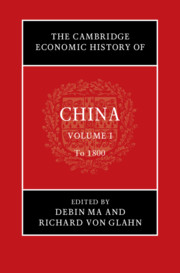Book contents
- The Cambridge Economic History of China
- The Cambridge Economic History of China
- The Cambridge Economic History of China
- Copyright page
- Contents
- Figures
- Maps
- Tables
- Contributors to Volume I
- Acknowledgments
- Note on Citations
- Introduction to Volume I
- Part I Before 1000
- Interlude
- Part II 1000 to 1800
- 7 Ecological Change and Resource Constraints
- 8 Population Change
- 9 Public Finance
- 10 Political Economy
- 11 Law and the Market Economy
- 12 Property Rights and Factor Markets
- 13 The Rural Economy
- 14 Cities and the Urban Economy
- 15 The Monetary System
- 16 Merchants and Commercial Networks
- 17 Foreign Trade
- 18 Production, Consumption, and Living Standards
- Bibliography of Primary Works Cited
- Index
- References
7 - Ecological Change and Resource Constraints
from Part II - 1000 to 1800
Published online by Cambridge University Press: 07 February 2022
- The Cambridge Economic History of China
- The Cambridge Economic History of China
- The Cambridge Economic History of China
- Copyright page
- Contents
- Figures
- Maps
- Tables
- Contributors to Volume I
- Acknowledgments
- Note on Citations
- Introduction to Volume I
- Part I Before 1000
- Interlude
- Part II 1000 to 1800
- 7 Ecological Change and Resource Constraints
- 8 Population Change
- 9 Public Finance
- 10 Political Economy
- 11 Law and the Market Economy
- 12 Property Rights and Factor Markets
- 13 The Rural Economy
- 14 Cities and the Urban Economy
- 15 The Monetary System
- 16 Merchants and Commercial Networks
- 17 Foreign Trade
- 18 Production, Consumption, and Living Standards
- Bibliography of Primary Works Cited
- Index
- References
Summary
Intricate relations between people, animals, and plants were the basis of the entire imperial Chinese order no matter what dynasty was ostensibly in charge. Such relations were environmental in the sense that they formed interdependencies between species under diverse ecological conditions of climate and topography. The most significant environmental historical result of these relations for the eight centuries under study here was agriculture, the main source of China’s human-induced (or “anthropogenic”) ecological change. An extended, instructive example of the intricacies of farming’s requisite resource management comes from the Ming (1368–1644) town of Pingwang in the Yangzi delta, likely the most developed area of contemporary imperial agrarian practice.
Keywords
- Type
- Chapter
- Information
- The Cambridge Economic History of China , pp. 259 - 299Publisher: Cambridge University PressPrint publication year: 2022



